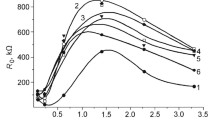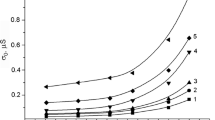To create highly sensitive semiconductor hydrogen sensors, nanosized tin dioxides with particle sizes of 5-6 and 10-11 nm have been obtained by the sol-gel method using various precursors, as well as Pd-doped materials on their base. The maximum sensitivity to the hydrogen microconcentrations has been found for the sensors based on the nanosized ex-oxalate SnO2 containing 0.24% palladium. High sensitivity of the obtained semiconductor sensors is explained by the significant influence of surface processes on their electrical resistance due to the smallest sizes of the SnO2 particles.


Similar content being viewed by others
References
G. Korotcenkov, S. D. Han, and J. R. Stetter, Chem. Rev., 109, 1402-1433 (2009).
G. Chen, J. Yu, and P. T. Lai, Microelectron. Reliab., 52, 1660-1664 (2012).
H. Jiang, M. Huang, Y. Yu et al., Sensors, 18, 94-102 (2018).
H. Yamazaki, Y. Hayashi, K. Masunishi, et al., J. Micromech. Microeng., 28, 094001 (2018).
J. T. Gurusamy, G. Putrio, R. D. Jeffery, et al., Sens. Actuators B, 281, 335-342 (2019).
Y. Zhang, H. Peng, X. Qian, et al., Sens. Actuators B, 244, 393-416 (2017).
X. She, Y. Shen, J. Wang, et al., Light Sci. Appl., 8, 4-1-4-10 (2019).
S. Barami, V. Ghafarinia, Sens. Actuators B, 293, 31-40 (2019).
Z. Cai, E. Goo, and S. Park, J. Mater. Res. Technol., 15, 1716-1731 (2021).
Z. Cai, S. Park, Sens. Actuators B, 322, 128651 (2020).
K. Hu, F. Wang, H. Liu, et al., Ceram. Int., 46, 1609-1614 (2020).
A. Marikutsa, M. Rumyantseva, A. Gaskov, et al., Inorg. Mater., 51, 1329-1347 (2015).
G. Fedorenko, L. Oleksenko, N. Maksymovych, and I. Vasylenko, J. Mater. Sci., 55, 16612-16624 (2020).
G. Fedorenko, L. Oleksenko, N. Maksymovych, and I. Matushko, Russ. J. Phys. Chem., 12, 2259-2262 (2015).
G. Fedorenko, L. Oleksenko, and N. Maksymovych, Adv. Mater. Sci. Eng., 2019, 5190235 (2019).
C. Xu, J. Tamaki, N. Miura, and N. Yamazoe, J. Mater. Sci., 27, 963-971 (1992).
C. Hammond, The basics of crystallography and diffraction, Oxford univ. press, Oxford (2009).
H. Borchert, E. Shevchenko, A. Robert, et al., Langmuir, 21, 1931-1936 (2005).
I. Vasylenko, S. Kolotilov, I. Kotenko, et al., J. Magn. Magn. Mater., 324, 595-601 (2012).
N. Yamazoe and K. Shimanoe, Sens. Actuators B, 138, 100-107 (2009).
E. Rounder, Chem. Soc. Rev., 35, 583-592 (2006).
K. Chatterjee, S. Chatterjee, A. Banerjee et al., Mater. Chem. Phys., 81, 33-38 (2003).
K. E. Geckeler and E. Rosenberg, Functional Nanomaterials, American Scientific Publishers, Valencia (2006).
L. Oleksenko, G. Fedorenko, and N. Maksymovych, Res. Chem. Intermed., 45, 4101-4111 (2019).
ACKNOWLEDGEMENTS
The work was performed with the support of the Ministry of Education and Science of Ukraine (a grant for the prospective development of the scientific direction “Mathematical Sciences and Natural Sciences Kyiv National University).
Author information
Authors and Affiliations
Corresponding author
Additional information
Translated from Teoretychna ta Eksperymentalna Khimiya, Vol. 58, No. 4, pp. 225-230, July-August, 2022.
Rights and permissions
Springer Nature or its licensor (e.g. a society or other partner) holds exclusive rights to this article under a publishing agreement with the author(s) or other rightsholder(s); author self-archiving of the accepted manuscript version of this article is solely governed by the terms of such publishing agreement and applicable law.
About this article
Cite this article
Maksymovych, N.P., Fedorenko, G.V. & Oleksenko, L.P. Nanosized Pd/SnO2 Materials for Semiconductor Hydrogen Sensors. Theor Exp Chem 58, 247–253 (2022). https://doi.org/10.1007/s11237-022-09741-6
Received:
Accepted:
Published:
Issue Date:
DOI: https://doi.org/10.1007/s11237-022-09741-6




